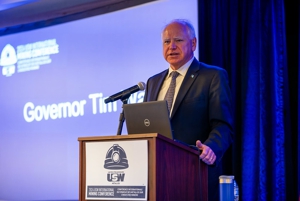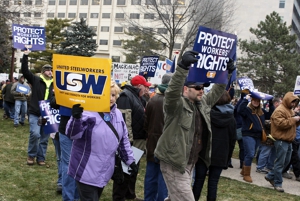Could 2014 Be Year One of the Pay Ratio Era?
Major U.S. execs now pull in, on average, over 350 times the pay of America’s rank-and-file workers. How high does that CEO-worker pay gap go at individual corporations? We’ll soon know.
The federal Securities and Exchange Commission, after four years of delay, will likely release this year new regulations that require America’s top corporations to annually reveal the ratio between their CEO and median worker compensation, a disclosure that the 2010 Dodd-Frank Act mandates.
The new SEC ratio disclosure regulations will kick in for the next corporate fiscal year. But activists aren’t waiting for the new pay ratio numbers to start emerging. They’re already mobilizing to build compensation ratios into the fabric of America’s economic life.
In Massachusetts, nurses have collected over 100,000 signatures for an initiative that would levy fines against any hospital in the state, profit or nonprofit, that compensates its CEO over 100 times the hospital’s lowest-paid worker.
State lawmakers now have until May to advance the nurses’ plan. If they don’t, nurses say they’ll collect the additional 11,000 signatures necessary to get their pay ratio plan on the November 2014 statewide ballot.
Similar ratio organizing has also hit another bastion of America’s growing inequality: college campuses. Compensation for academe’s top executives has been riding a steep up escalator over recent years, at the same time pay for faculty and campus staff has been struggling just to keep pace with inflation.
Students on these campuses, meanwhile, are graduating into ever greater debt, and all these dynamics, combined, may help make the nation’s colleges the coming year’s most heated pay ratio battleground.
At St. Mary’s College, a prestigious public liberal arts campus in southern Maryland, the pay-ratio battle has already begun.
Students at St. Mary’s have been organizing for pay justice for over a decade now. Between 2002 and 2006, their campaign for a campus-wide living wage jumped the college’s lowest annual pay rate from $15,700 to $24,500.
But inflation since 2006 has eroded that wage minimum. Pay for top college administrators, by contrast, has increased, even during what was supposed to be a statewide wage freeze.
This past September, students and allied faculty and staff formally unveiled a response to this newly widening gap: a proposal for a new campus-wide pay plan that would set their college’s lowest pay at 130 percent the official federal poverty level for a family of four and limit the pay for the St. Mary’s president to just ten times that lowest base pay.
This 1:10 ratio proposal will be going before the St. Mary’s student government association and faculty and staff senates over the next few months. The next goal after that: approval from the college’s board of trustees.
Activists at St. Mary’s College have a broader goal as well. They’re hoping, as St. Mary’s emerita professor of psychology Laraine Glidden noted to Too Much last week, to “not only address the wage inequity on our campus, but also inspire others to similar efforts.”
And the St. Mary’s activists appear to be succeeding on that score. Activists on other campuses have already made contact with them.
Those contacts will probably be multiplying in the year ahead. Just before the holidays, the Chronicle for Higher Education reported that 42 private college presidents in the United States took home over $1 million in 2011, the most recent year with pay data available.
Two of these top college officials made over $3 million, a take-home almost 200 times the pay of a minimum-wage worker.
***
This post originally appeared at Campaign for America’s Future (CAF) at their Blog for OurFuture. Sign up here for the CAF daily summary.
By clicking Sign Up you're confirming that you agree with our Terms and Conditions.
Related Blogs
Ready to make a difference?
Are you and your coworkers ready to negotiate together for bigger paychecks, stronger benefits and better lives?

